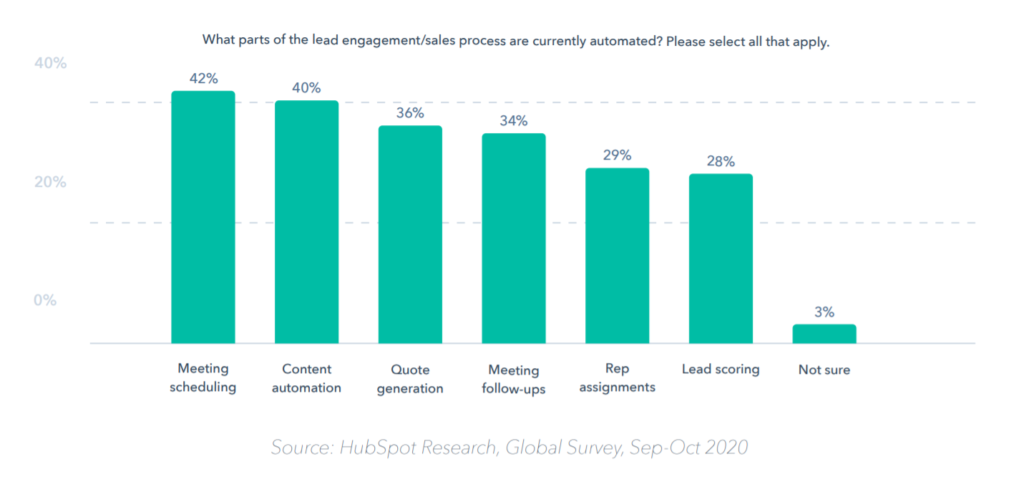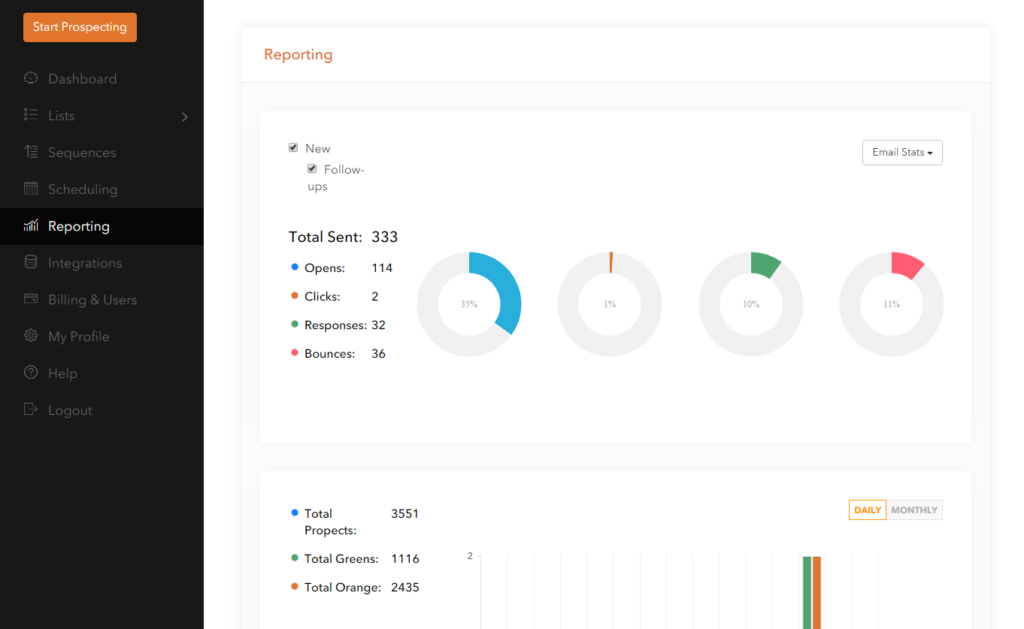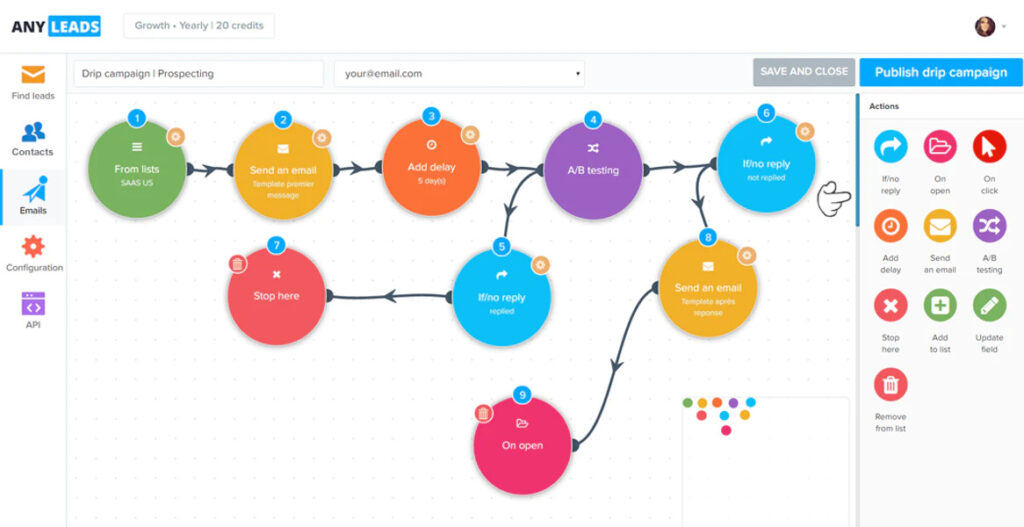A sales process is a plan aimed to turn a prospect into a customer as quickly as possible. It encompasses a defined series of steps a consumer goes through with a company (particularly with a salesperson).
Basically, it is an outline of a potential customer’s journey that most companies use to simplify and speed up deals closing.
At the same time, there is evidence that an average salesperson spends just about 15% of their time actually selling. The rest of their time is taken by dealing with product issues, getting approvals, participating in meetings, and doing research.
Imagine what taking some of these tasks off your sales team’s shoulders could do to your revenue? While every salesperson has their own sales strategy, a survey claims that 61% of companies that automated their sales processes have outperformed their revenue goals for 2020.

If you use a platform like Shopify to run your online business, that’s great. This means you can automate many things on the platform. However, it’s still important to see how you can eliminate the routine and drive more revenue with the help of sales automation.
1. Prospecting automation
Scouring the internet for prospects, searching for their contacts, crafting personalized emails is just some part of the work a salesperson has to do daily. Enabling your employees to delegate these tasks to software can free up a lion’s share of time they can use to sell.
Furthermore, when your sales reps can do what they do best, they will be more motivated. By introducing automation to areas everyone hates to do — like cold-calling, for example, — you’ll boost engagement and pleasure from work.
And finally, with a motivated and productive salesforce that performs at its peak level, your revenue will inevitably grow. The only trick is to choose the right automation tools for your business.
Leadfuze

Leadfuze tool allows automation of outbound sales prospecting (aka lead generation) by capturing prospects’ details. A user can type in parameters like organizational role, industry, preferred software, Google Ads spending and get a list of promising leads along with their contacts. All that’s left is to review the crucial information about a person and craft an email.
Leadfuze easily integrates with HubSpot, Salesforce, Zapier and Google Workspace.
Anyleads

With Anyleads, sales reps can set criteria and generate data-rich reports. The tool also hunts emails for specific prospects. What’s more, the tool comes with a handy email editor where you can choose from a number of templates. Emails can be scheduled and tracked, so you can easily estimate your campaign’s efficiency. Once you made your choice, ensure the automation tool integrates well with your CRM, calendar, and email marketing software. Ensure that your provider’s FAQ tool allows for easy search of necessary guidelines and contact support to see if they can assist you with configuring.
Sales preparation automation
Your prospective customers interacting with your company stay at different stages of the buyer’s journey. Depending on a stage, they need different experiences and are ready for different interactions. Thus, before contacting a prospect, you need to determine how ready they are to make the contact as efficient as possible.
This process can be automated using several tactics. One of them is lead scoring.
Each action that shows interest from the lead in your company’s services or products, is assigned a numerical value. When a lead has accumulated enough points to get an SQL (sales qualified lead), a sales team receives a notification that they should follow up this lead.
Another way to weed out leads who are not the best fit is to use smart forms. These are dynamic forms that can show different fields depending on the information entered. For instance, if you’re B2B only, you can create a form asking if a user is a business or a consumer, especially if you use cloud phone systems. After they select “business”, the form will ask for their company name or display a warning message in case a user selects “consumer”.
With smart forms, you can capture relevant leads’ information and alert your sales team to follow up.
Similarly to smart forms, chatbots can gather information to qualify the lead and integrate it within your CRM. These pieces of software programmed to perform certain actions work excellent for sales enablement and users’ details collecting.
Nurturing workflows is another lead qualification automation tactic. A lead is provided with relevant and encouraging content at each stage of their buyer’s journey. Once the workflow’s goal is reached (say, someone at the awareness stage has downloaded your whitepaper), another workflow is triggered that sends them a series of nurturing emails until they are ready to speak with a sales agent.
If the lead stays inactive for a while, they are removed from the workflow or left alone for some time to try to re-engage them later.
Sales approach automation
Having a contact email and phone is just a start. A prospect becomes a lead only after they showed interest in your product or service. That’s why cold outreach is important.
With over 4 billion users worldwide, email stays a popular communication channel. And many sales reps use it as a means of first contact with a lead. Yet, email comes with many drawbacks. Thus, you have to stay organized in hundreds of emails, keep track of the need to follow up or check in with a person. If you’re mistaken and send the wrong message or forget to get back to a lead, you can lose that sale.
An automation tool can help by allowing a salesperson to schedule follow-up emails to be sent at certain time intervals. The use of templates speeds up the outreach process, as you only have to create a personalized message for a segment of your audience — not every person on the list.
Scheduling a meeting is another tedious and time-consuming task. You suggest a time and a date, a lead returns with a suggestion of their own — the process can take weeks. With an automated scheduling tool, a sales rep can share a link to available slots in their calendar for the lead to choose from. A reminder can be set to come to both the lead and the salesperson before the meeting.
Presentations automation
Creating pitch books takes time and effort. Keeping them up-to-date and sharing with the marketing and content teams to ensure everyone is on the same page takes even more time and trouble. There is plenty of room for error, that’s why many managers seek automated presentation management solutions. Yet, that’s the point where tension tends to build up.
Every sales rep has their own way of selling — including the type and usage of materials. What’s good for a marketing specialist doesn’t necessarily meet the needs of a sales agent.
So, while a unified product or service proposal is beneficial for all teams, it might not work for each of them the best way. This takes us to the necessity of having a proposal creation tool that allows for flexibility within rigid compliance controls. A salesperson should be able to make illustrations, texts, and rearrange things to their comfort.
Another thing a good presentation automation tool can help with is keeping reports up to date. A CRM integrated solution can build hypothetical portfolios based on the available data and also keep record of everything that has been shown to a particular client throughout their lifetime with the company.Some popular tools for sales documents management are PandaDoc and Qwilr. Qwilr offers a vast collection of templates along with a drag and drop option to create interactive proposals. It also tracks openings and the time a prospect spent looking at the file.

PandaDoc tops all the mentioned features with free access to e-signs. It significantly saves from the necessity to print multiple copies of documents. Some people express dissatisfaction from getting too many notifications as someone makes changes in their documents, but other than that, it is a great tool.

5. Closing sales automation
Effective sales often come down to having a solid lead list. Yet, searching for potential customers and questioning them if they are interested in your product or service is a draining task. With a list building tool, though, you can get a list of people that are ready for your sales team to reach out. An example of a popular list building tool is LinkedIn Sales Navigator.
For a tool to return a relevant list, give it the desired job title, industry, or location. LinkedIn Sales Navigator pulls the information from LinkedIn profiles. Other tools may use different resources, that’s why it’s recommended to do a little research and before contacting a prospect.
Of course, knowing a person’s name and a job title doesn’t guarantee a successful sale closing. For collecting insights, there is yet another kind of automation tools — tools for lead enrichment.
These tools pull information about your leads from authoritative sources and give you a complete profile, regularly updating the information.
6. Follow-up sequences automation
Many automation tools can also be configured to send sequences of emails depending on a lead’s answers. It is especially useful in the B2B sector, since the long sales cycle increases the chance of a customer quitting the buyer’s journey before they reach its end.
Email drip campaigns help to nurture the lead’s interest, giving bits of value with each email while always keeping the product or service top of mind. Setting up a campaign right after the presentation will minimize the risk of the customer forgetting about your company. Plus, it will reduce the odds of a salesperson missing the opportunity for sale and speed up the sales process altogether.
Among the top popular email drip software, there is AWeber. They offer a free campaign builder where you can design emails, save templates, schedule and apply tags.

For minimalists, there is Flodesk. Here, you have several pre-built templates that you can customize. The tool allows time-release sequences and track openings. Online reviews also praise the customer support team’s stellar skills of Flodesk.

Summary
Sales automation tools can help close sales faster and streamline the activities. However, none of them will be effective if there is a lack of planning or a sales process undefined. In order to put automation to effective work, a salesperson should be able to pick the right data and know how to use it.
All in all, sales can be done without any software assistance. Automation tools are called to cut monotonous work and let sales reps direct their energy to pursue customers that are ready to buy. At that, they can increase capacity, not replace the human.

Julia Serdiuk is an outreach specialist at HelpCrunch, an innovative platform to build relationships with customers. She is a seasoned traveller and yoga enthusiast. Appreciates life and believes in the cloudless future of our planet.










